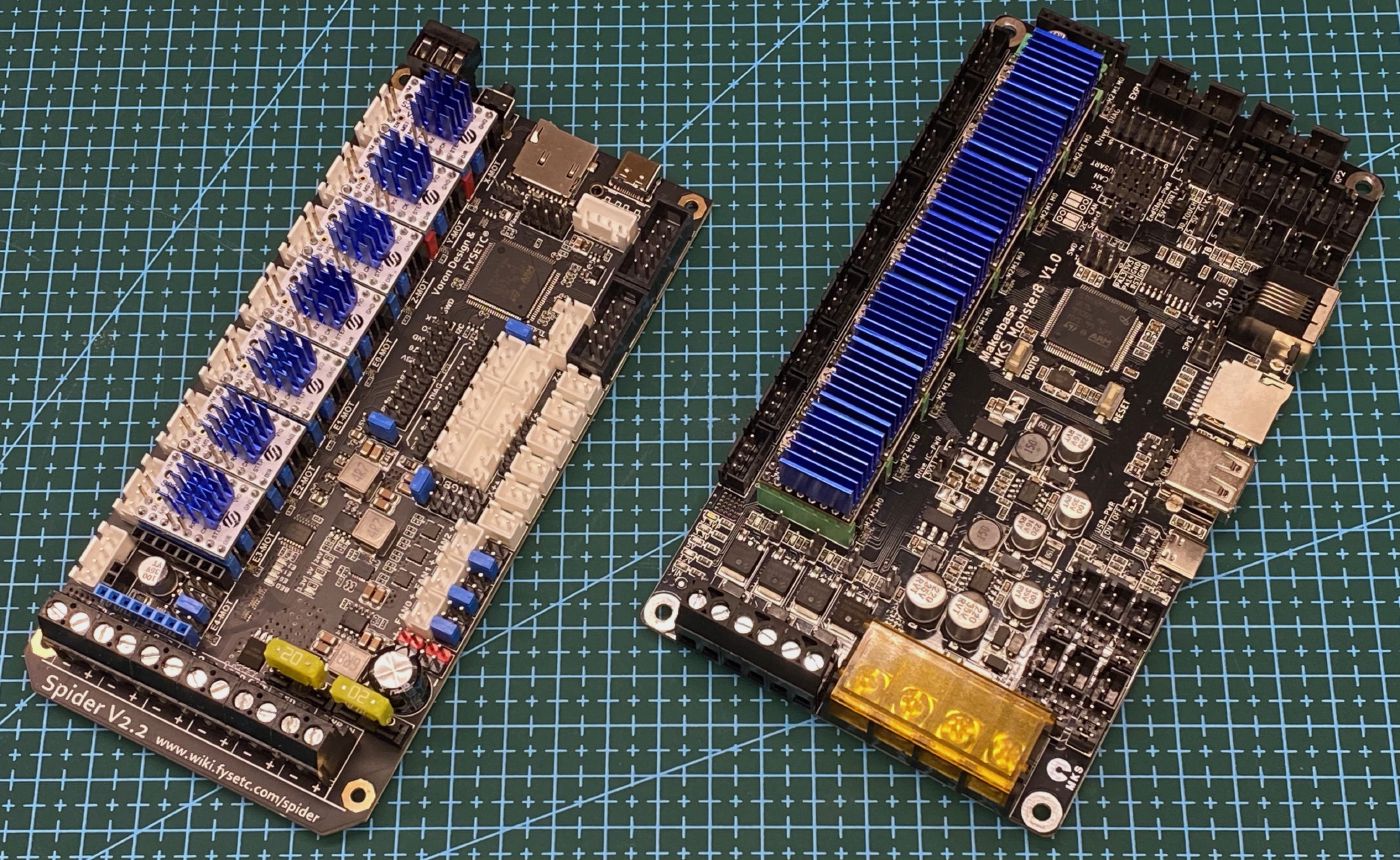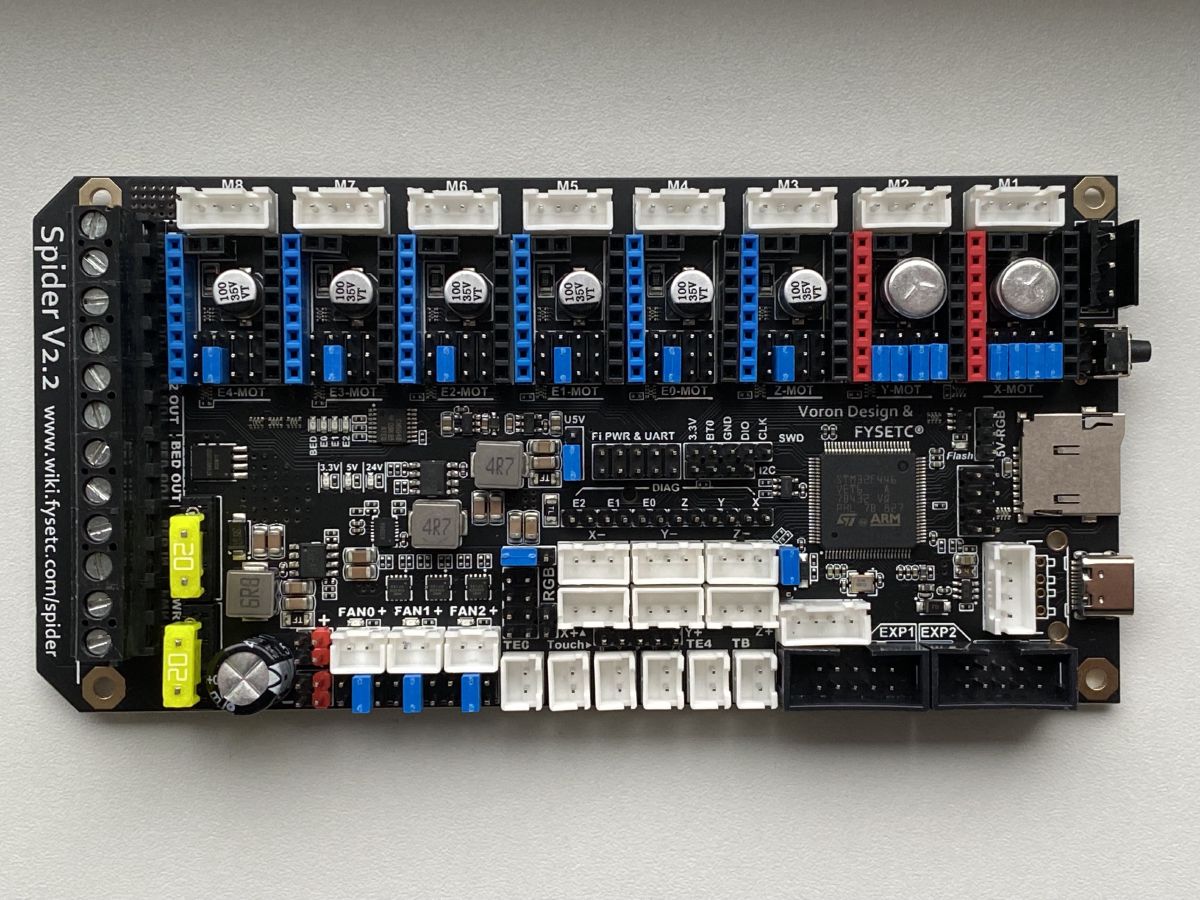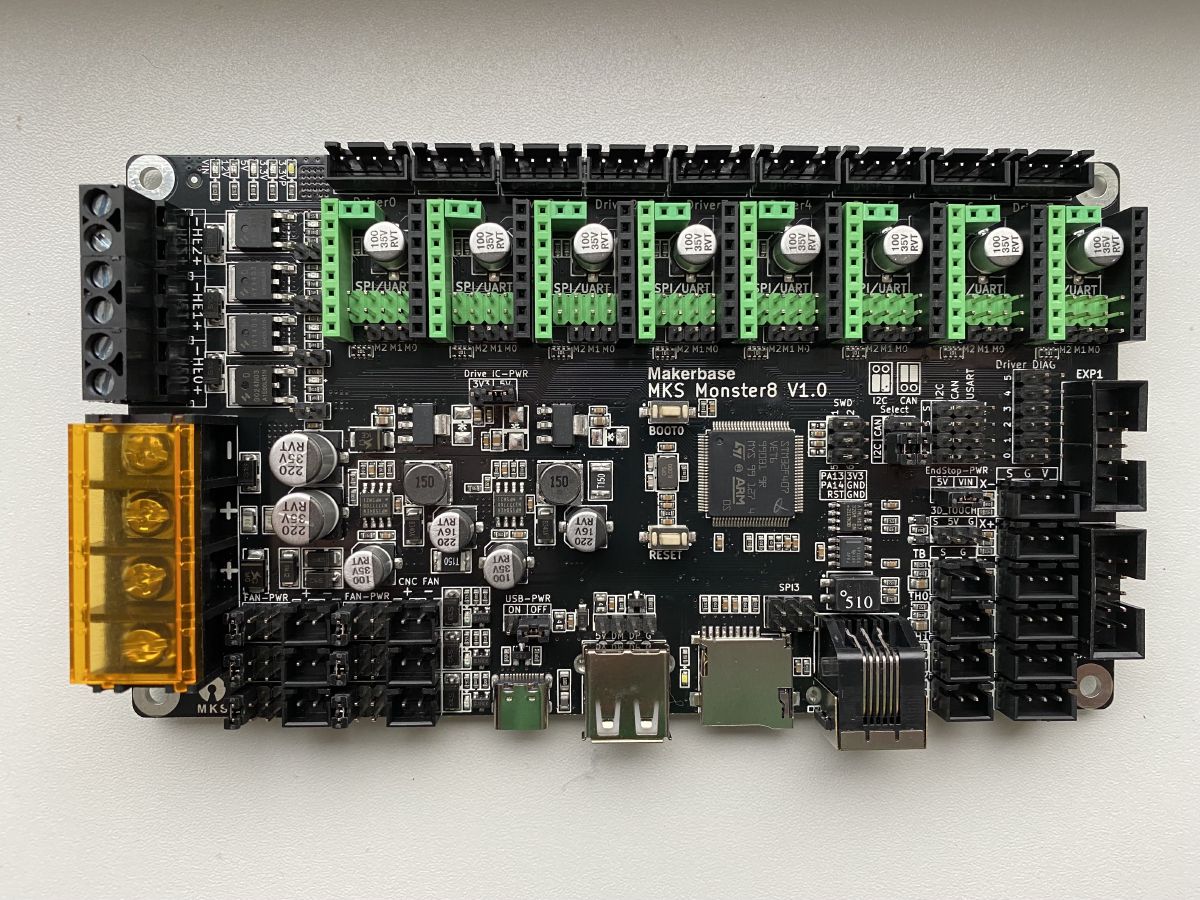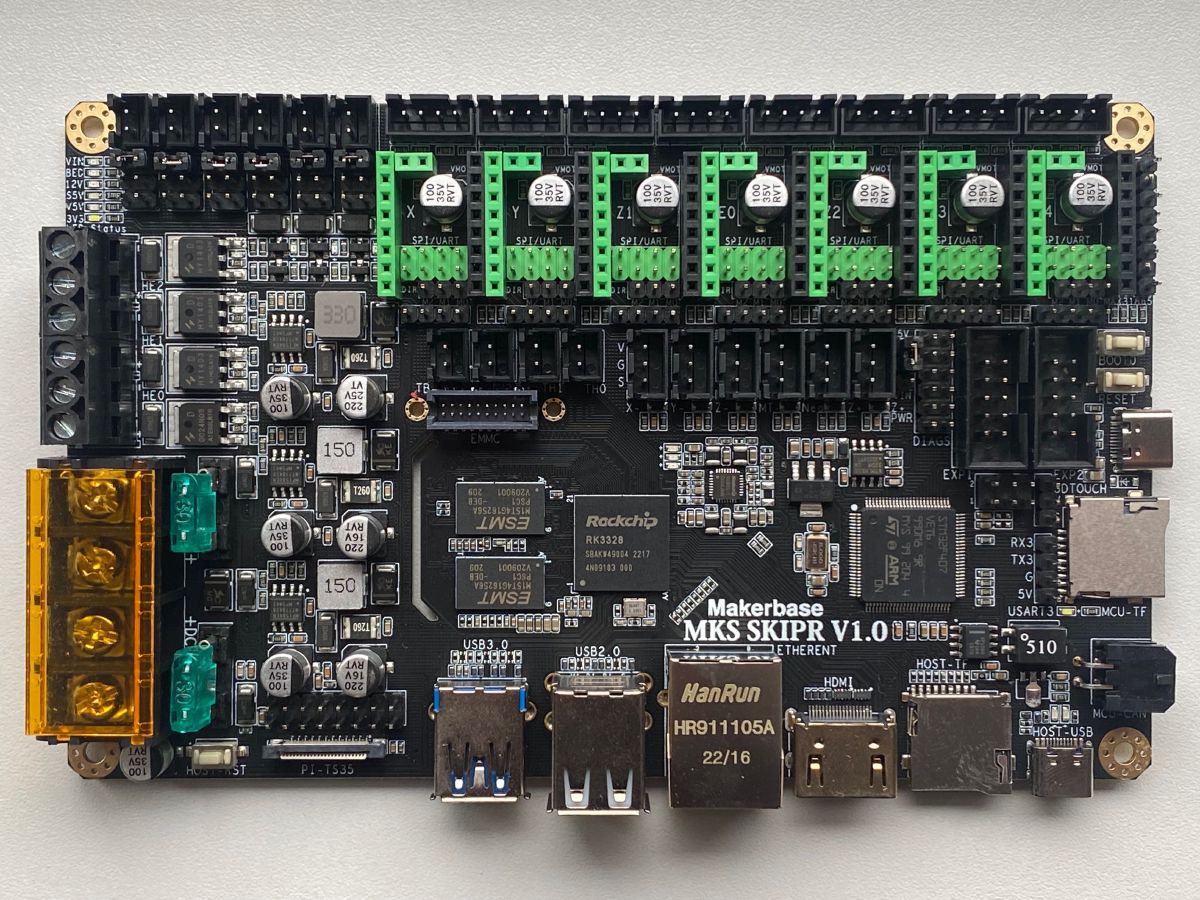Which controller board to choose for your Voron?
Table of Contents

Voron 2.4 and Voron Trident are advanced 3D printers running more stepper motors than a basic 3D printer. You used to need two controller boards to run these printers, but recently multiple affordable 8 stepper boards were released. I tested and compared BIGTREETECH Octopus, Manta M8P, FYSETC Spider, Makerbase MKS Monster 8 and Mellow Super 8.
Updated in Septemper 2023 to include the latest generation of boards with integrated Klipper host.
Controller boards
All of these boards have the necessary features to run a Voron printer equally well. Here are some of the common highlights:
-
Drives 8 steppers. They can run all motors on Voron 2.4 and still have a spare stepper slot for an extra extruder for example. You no longer need to combine multiple boards.
-
Switchable 5/12/24V rails for fans and accessories. It is one of the best improvements in this new generation of boards, and I hope it will make it into the smaller boards as well. It enables to run 5V/12V fans a lot easier, which opens up a lot wider selection of fans you can use.
Let’s look at the differences.
FYSETC Spider 2.2

FYSETC Spider is one of the most popular controller boards for Voron printers. FYSETC had quality issues with their early Spider boards, but the boards have been revised and fixed. I received Spider 2.2, which even has some new features compared to the original Spider. The latest boards support 48V on A/B motors and have a dedicated 5V circuit for powering a Raspberry Pi. I also like the compact form factor compared to the other boards. It will make it easier to install it in more compact printers. I hope to test out the 48V capability and report soon. I have been running this board for a couple of weeks now without any issues. I will keep using this board, and I will update this post regarding long-term reliability after a while.
Makerbase MKS Monster 8

Monster 8 was released a lot later than the other boards and there are fewer people using it. I expected I would not be able to find configuration examples and have a hard time setting everything up from scratch. However, I was pleasantly surprised with the resources provided by Makerbase: it comes with STLs for the bracket like any other Voron board, it has Klipper config examples and a guide for Voron 2.4.
Monster 8 is the most affordable board out there. I’ve only been running it for a couple of weeks, but I had other Makerbase boards in the past and they never failed on me. My only complaint is that Monster 8 doesn’t have enough power on 5V rail to power a Raspberry Pi. I would prefer if I didn’t need an additional 5V power supply.
UPDATE: Monster 8 was updated to V2 which got an independent 3A power supply for Raspberry Pi.
Comparison table
| BTT Octopus | BTT Octopus Pro | FYSETC Spider 2.2 | Makerbase Monster 8 V2 | Mellow Super 8 | |
|---|---|---|---|---|---|
| Chip | STM32F446 | STM32F446/ STM32F429 | STM32F446 | STM32F407 | STM32F407 |
| Full RRF support | No | No/Yes | No | No | Yes |
| 5V regulator | 8A | 8A | 5A+3A | 3A+3A | 5A |
| 12V regulator | 4A | 4A | 3A | 3A | Unknown |
| 48V capability | No | Yes (x8) | Yes (x2) | No | Yes (x3) |
| PWM fans1 | 6 (9) | 6 (9) | 3 (8) | 3 (5) | 10 (14) |
| CAN port | Yes | Yes | No2 | Yes | Yes |
| Size | 160x100 | 160x100 | 155x77 | 160x90 | 156x110 |
| PT100/ PT1000 | No/No | Yes/Yes | No/Yes | No/No | Unknown |
| Onboard WiFi | No | No | No | No | Yes |
| Price | $45 | $55/$60 | $45 | $40 | $65 |
Controller boards with integrated Klipper host
These are the second generation of Voron specific boards. The success of Klipper and the shortage of Raspberry Pi boards pushed manufacturers to create new products. These boards have an ARM CPU capable to run Linux and thus to run Klipper host as well. It’s a big step forward: like the first generation of boards eliminated the need to have two controller boards, they eliminate the need of a seperate Klipper host device like Raspberry Pi.
BTT Manta M8P
Technically Manta M8P doesn’t have an integrated Klipper host but it has a board-to-board connector for a Raspberry Pi Compute Module 4 (CM4) or an equivalent board. This design is useful in case of hardware failure or as a way to reuse compute boards between projects. If you don’t already have a RPi CM4, BTT sells it with their own compute module - CB1. It performs similar to Raspberry Pi 3 which is plenty for running Klipper. The only thing missing on this board is CAN port. You will need a CAN adapter if you want to use CAN bus to the toolhead.
Makerbase MKS SKIPR

MKS SKIPR comes in a form factor very similar to Monster 8 but has essentially MKS Pi built into it. Unlike CB1 or CM4 it doesn’t have WiFi chip but you can get a USB WiFi dongle as a $3 option. On the other hand it has eMMC storage option which suppose to be a lot more reliable compared to SD cards. Makerbase sells a bundle that includes the board, eMMC storage, WiFi dongle and an LCD screen for $82, that’s value hard to beat. I will run this on my Voron 2.4 and update this post with long term review of this board.
Comparison table
| BTT Manta M8P 1.1/2.0 + CB1 | Makerbase MKS SKIPR | |
|---|---|---|
| SOC | Allwinner H616 | Rockchip RK3328 |
| CPU | 1.5GHz A53 | 1.5GHz A53 |
| RAM | 512MB/1GB DDR3 | 1GB DDR3 |
| MCU | STM32G0B1VET6 / STM32H723ZET6 | STM32F407VET6 |
| 5V regulator | 5A | 3A+3A |
| 12V regulator | 5A | 3A |
| 48V capability | Yes (x8) | No |
| PWM fans1 | 7 (10) | 3 (5) |
| CAN port | Yes | Yes |
| Size | 170x103 | 160x100 |
| PT100/PT1000 | Yes/Yes | No/No |
| Onboard WiFi | Yes | No3 |
| eMMC Support | Optional | Yes |
| Price | $79 | $60 |
Which one to get?
First of all, the board choice will not affect the print quality or the speed of your printer. You should decide based on the features you are going to use. For a new build I would prefer one of the new boards with an integrated Klipper host. They are cheaper and more compact:
-
MKS SKIPR is a very cost effective solution. It has all the features required to run a Voron printer. It even includes a CAN bus which is becoming a very popular mod in the community. You can get a bundle with a WiFi dongle, eMMC storage and a KlipperScreen compatible display for just $82 that’s a lot of value for the buck.
-
BTT Manta M8P has some extra features like 48V, PT100 sensor support and the ability to replace the compute module. I recommend getting it with BTT CB1 module (and TMC2209 drivers) which is gonna save a lot of money compared to getting a Raspberry Pi. The best place to get it is Biqu official store.
If I already had a Raspberry Pi or for some reason wanted to use Marlin or RepRap firmware then I would look at the pure controller boards:
-
Monster 8 is the most affordable board and a good choice for the most.
-
FYSETC Spider adds some frequently used extra features: it has a dedicated power rail for Raspberry Pi, and it can run 48V on A/B motors (where it matters). It’s also the most compact board.
-
BTT Octopus Pro is the most feature-rich board. However, very few people need the extras above Spider, like full RepRap firmware support (STM32F429 version), 48V on other than A/B drivers, or in-built PT100 sensor support. The best place to get BTT products is Biqu official store.
-
Mellow Super 8 is quite expensive board with a rather interesting set of features. It’s the only pure controller board to include onboard WiFi but this will only appeal to RepRap or Marlin firmware users.
Let me know which one would you choose in the comments below.
Disclaimer: FYSETC and Makerbase provided their boards for testing free of charge, but did not have any influence on the content.